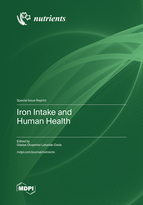Iron Intake and Human Health
A special issue of Nutrients (ISSN 2072-6643).
Deadline for manuscript submissions: closed (15 March 2019) | Viewed by 45119
Special Issue Editor
Special Issue Information
Dear Colleagues,
Iron is an essential micronutrient that is important for cellular and physiological processes, such as respiration, energy metabolism, replication, and gene regulation. Dietary iron is absorbed principally from the proximal duodenum in a regulated process that modulates iron homeostasis since iron excretion is not regulated in humans. Iron in foods is present in two forms, heme (meat types) and non-heme (vegetables and cereals). Recent publications have revealed iron bioavailability data on novel food products, new oral iron supplements or iron biofortifed foods that are safe and less toxic to the gut. Moreover, food processing procedures such as micro-milling or food encapsulation are employed to influence luminal bioaccessibilty and iron absorption from foods. Furthermore, gut microflora have emerged as important entities that modify food matrices, metabolites and modulate iron absorption in distal gut region. While the mechanism of heme iron absorption is still not resolved, intake and absorption of non-heme iron involve a regulated interplay of an apical ferrireduction, ferrous ion absorption by DMT1 symporter, abluminal efflux by ferroportin and ferroxidation by haphaestin. This intestinal transit machinery is regulated by transcriptional Hif-2α activation, post-transcriptional IRP-IRE binding and the post-translational inhibitory mechanism by hepcidin. Emerging evidence in recent years is, however, alluding to the modulation of the transport machinery by luminal bioactive ingredients or dietary constituents. Moreover, disorders of the gastrointestinal tract are common in chronic diseases with increased inflammation and hepcidin levels that result in a reduced iron intake and subsequently systemic iron deficiency. In contrast, genetic diseases such as mutation in genes that regulate hepcidin and ferroportin expression lead to inappropriately low hepcidin levels that promote iron absorption and result in iron overload.
Dr. Gladys Oluyemisi Latunde-Dada
Guest Editor
Manuscript Submission Information
Manuscripts should be submitted online at www.mdpi.com by registering and logging in to this website. Once you are registered, click here to go to the submission form. Manuscripts can be submitted until the deadline. All submissions that pass pre-check are peer-reviewed. Accepted papers will be published continuously in the journal (as soon as accepted) and will be listed together on the special issue website. Research articles, review articles as well as short communications are invited. For planned papers, a title and short abstract (about 100 words) can be sent to the Editorial Office for announcement on this website.
Submitted manuscripts should not have been published previously, nor be under consideration for publication elsewhere (except conference proceedings papers). All manuscripts are thoroughly refereed through a single-blind peer-review process. A guide for authors and other relevant information for submission of manuscripts is available on the Instructions for Authors page. Nutrients is an international peer-reviewed open access semimonthly journal published by MDPI.
Please visit the Instructions for Authors page before submitting a manuscript. The Article Processing Charge (APC) for publication in this open access journal is 2900 CHF (Swiss Francs). Submitted papers should be well formatted and use good English. Authors may use MDPI's English editing service prior to publication or during author revisions.
Keywords
- Iron
- Intake
- Processing
- Bioavailability







